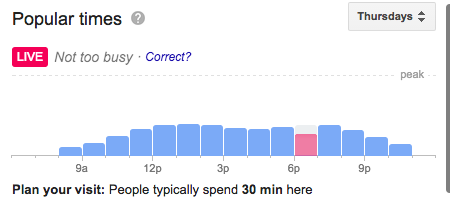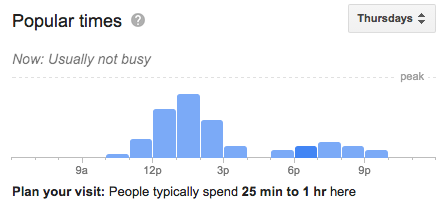Machine learning is predicted to change the world at a similar scale or greater than the industrial revolution in the nineteenth century.
While still in its early stages, machine learning has already had a significant impact on different aspects of everyday life. Chances are you’ve already interacted or heard of how machine learning is being used today:
- Google is using machine learning to train driverless cars, which will change how we move.
- The “People You May Know” feature on Facebook, which opens us to a new network of people.
- The evolution of semantic-based search results in search engines.
It’s clear how machine learning has the potential to transform everything, from transportation to the way we communicate, and it doesn’t take much imagination to see how machine learning is going to change things for local stores, as well.
Since machine learning algorithms feed off data to create patterns, Google has been in a powerful position to make an impact on everything from online search to local retail. With over 3.5 billion searches a day, and an incomprehensible amount of user data, Google’s machine efforts can and have been making an immediate impact.
Here’s how Google’s machine learning is impacting local stores’ traffic, and what we can expect in the future:
What Is Machine Learning?
By definition, machine learning is a type of artificial intelligence that enables computers to learn without further explicit instruction from a programmer. Essentially, machine learning involves finding patterns and adjusting program actions as needed.
Most people are more familiar with machine learning from a non-technical perspective. For example, Netflix’s machine learning capabilities can predict what show you will probably be interested in next based on what you’ve just finished watching. Similarly, Amazon’s machine learning capabilities can make product recommendations based on your viewing and purchasing history.
Machine Learning and Local Store Traffic
The sheer amount of information and analytics available in the world of retail is what is making machine learning a very effective solution for local stores.
If you’ve used Google to find information about a local store, you may have seen a handy little bar graph highlighting the busy times of the store. Google compiles this information by using the mobile phone GPS location signals and Wi-Fi connectivity of those who have enabled Location History/Services to determine where users are.

Once Google has enough data about location times, it can predict the most popular times even if the search isn’t “live.” The implication that this has on store traffic is that traffic which has previously researched the location might be more inclined to visit during a time that is less busy. For example, the above graph describes the traffic at a local Target Supermarket and shows a relatively steady, uniform series of data points.

In contrast, this bar graph describes the traffic of a local restaurant. Based on the information provided, it is a popular lunch spot but isn’t so popular around dinner time, as well being typically empty at 4 p.m., as most restaurants are. If traffic were inclined to visit this restaurant but didn’t want to spend a lot of time in line or waiting to be served, they would likely opt for the less busy times, evening out the distribution.
Tracking your phone’s location to estimate wait times is not a novel idea; it has been used in Google Maps to estimate traffic times for a few years, now.
Machine Learning Can Improve the Shopping Experience
Machine learning’s reach extends far past the distribution of local store traffic. Local stores can tap into big data analytics and machine learning to source products from outside vendors or provide recommendations based on basic things such as the price and quantity, and even the more complex components such as the place the item sits on a shelf and the best marketing channel to reach out to the right customer in a specific area.
Through machine learning, local stores will be able to help the right customer find the right product at the right time. The impact this has on local store traffic could either increase the number of people walking through local stores or decrease the amount of time spent in the store since they are more likely to find the item they are looking for based on machine learning predictive analytics.
The Future of Google’s Machine Learning and Local Store Traffic
Technology has allowed local stores to create an index of virtually every product in existence, and machine learning is going to help them to pair this information with customer shopping habits to provide a convenience that is otherwise more difficult and expensive to do.
Local stores will not only be able to offer customers a much better experience, they will be able to better understand the best landscape to open up new locations based on foot and car traffic patterns. Trained algorithms can predict the popularity of certain locations and take into account everything from competitors to average customer lifetime value in certain areas.
As far as Google’s machine learning goes, it only seems to be continuously advancing and becoming a larger part of everyday life. Google’s CEO, Sundar Pichai, noted that machine learning is becoming an integral part of every component of Google:
“Machine learning is a core, transformative way by which we’re rethinking how we’re doing everything. We are thoughtfully applying it across all our products, be it search, ads, YouTube, or Play. And we’re in early days, but you will see us — in a systematic way — apply machine learning in all these areas.”
As Google’s Machine Learning algorithm advances and Google Shopping updates continue to change the way local stores interact with their shoppers, new strategies will emerge to capitalize on new in-store and online traffic patterns.
Final Thoughts
Artificial intelligence isn’t just a marketing trend, it’s a technological breakthrough that has the potential to completely change the retail game in a short period of time. Machine learning is massively scalable and improves with the amount of information it has to work with.
Complex tasks that were previously only done by humans could soon be transitioned to a tireless, high-quality digital workforce. Machine learning has impacted and will continue to change the landscape of local store traffic, and local stores that figure out a way to best use Google’s machine learning algorithms and local SEO to their benefit will ultimately be able to provide their new traffic a better experience.
Authored by:
 Ronald Dod is the Chief Marketing Officer and Co-founder of Visiture an end-to-end eCommerce marketing agency focused on helping online merchants acquire more customers through the use of search engines, social media platforms, marketplaces, and their online storefronts. His passion is helping leading brands use data to make more effective decisions in order to drive new traffic and conversions.
Ronald Dod is the Chief Marketing Officer and Co-founder of Visiture an end-to-end eCommerce marketing agency focused on helping online merchants acquire more customers through the use of search engines, social media platforms, marketplaces, and their online storefronts. His passion is helping leading brands use data to make more effective decisions in order to drive new traffic and conversions.
The post How Google’s Machine Learning Is Impacting Local Store Traffic appeared first on SmallBizTechnology.
from SmallBizTechnology http://bit.ly/2RD4X0m
via https://ifttt.com/ IFTTT
No comments:
Post a Comment